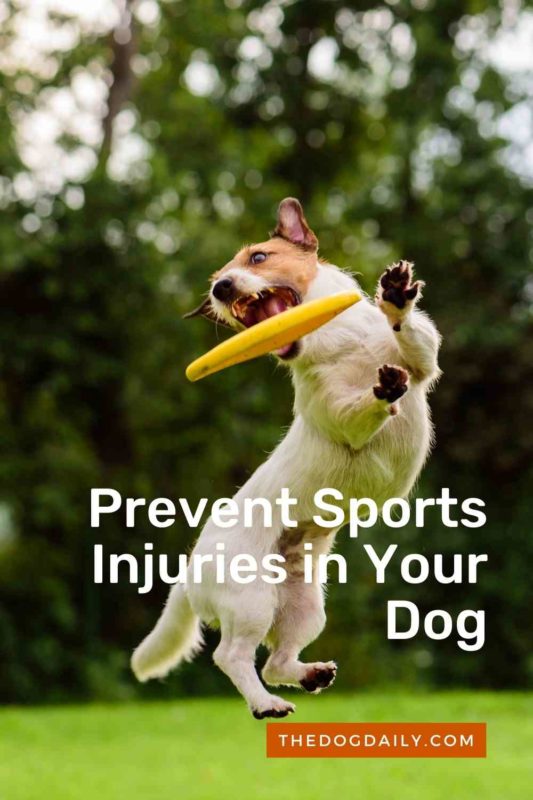Sport Related Dog Injuries
If your dog is a sled dog racing over icy terrain, a weekend warrior chasing balls, or any other kind of canine athlete, there’s a chance that your dog will overdo it. Since now more than ever, we include our dogs in our sports activities and exercise routines, there is a higher risk of physical injury. Experts say that strained muscles and tender paw pads are common minor injuries. At the same time, more significant hurt can include shoulder instability, back problems, and a ruptured anterior cruciate ligament (similar to the knee injury that plagues human athletes).
So how can you tell if your dog’s sports-related injury is treatable at home with some TLC or if it needs immediate veterinary care?
Minor injuries for homecare include:
-
Tender pads
Rest is likely in order. Try to keep your dog off rough, irritating surfaces for a while so that its pads will get a chance to heal.
-
Soreness or stiffness
If your dog seems a bit sore or stiff, rest again might be the ticket. Ice can offer some relief if you’re patient enough to sit with your dog for about 15 minutes. Dampen the area you’re icing and apply a thin, damp towel warmed with slightly heated water, instructs Paulekas. Then apply the cold pack. Wrap it with an insulating towel for compression. Pet and reassure your dog, offering the occasional treat. Allow your dog to rest easy for the next few days so that it may recover.
Pay special attention (and keep your veterinarian’s phone number handy) if you notice your dog:
-
Refusing to bear weight
If your dog can’t hold weight on a leg or is continually lifting a paw, it’s best to see your veterinarian, as this could indicate a ligament tear or other damage to a leg.
-
Continuing to limp or cry
Dr. Becky Paulekas, a Garden City, Idaho veterinarian with canine rehabilitation expertise, suggests visiting your veterinarian if, after several hours, your dog is still noticeably lame or cries when you touch an injured part of its anatomy. Persistent lameness could mean damage to a joint or another serious problem, rather than just a bruise or muscle soreness.
-
Bobbing head
Shoulder injuries can be subtle. If you notice your dog bobbing its head or moving its shoulder excessively, visit your veterinarian. Affected dogs might also not lift their paws much when they walk.
Knowing your dog well and being observant about its health and personality are the best defense against sports injuries, says Paulekas. For example, your dog might be so eager to earn your favor that it will keep fetching a stick over and over, ignoring a muscle strain or exhaustion. “The dog wants to please you,” Paulekas says. “The dog has no concept of being sore the next day.”
It can help research what sorts of activities your dog’s breed was initially intended to perform, says Seth Chodosh, founder of Running Paws, a Manhattan-based dog-jogging service, and canine athletic club. After all, a tiny Pomeranian isn’t likely to make an excellent jogging partner, and an energetic Border Collie probably won’t enjoy sedate, leisurely walks around the block.
Without a doubt, exercise and physical activity are enjoyable, essential components of your dog’s life. But it’s up to you to understand your furry friend’s limits and to recognize when your dog has overdone it. Dogs are generally more durable than people, says Chodosh. He adds, “The most important part to remember is an injury can happen to any dog, from a Chihuahua to a Great Dane.’’
It’s best to avoid these injuries in the first place since they can affect your pup for life.
Here are some factors that could place your dog at risk for a sports-related injury:
-
Your dog’s weight
“One of the biggest risk factors I see is obesity,” says Jennifer Hill, a canine physical therapist in Helena, Mont. “That extra poundage just puts so much more stress and strain on joints.” Activities that involve sharp turns and jumping could significantly add to that strain.
-
Your dog’s age
Activities involving jumping or running might place too much strain on a dog suffering from arthritis, which can develop as your dog gets older.
-
Your dog’s confirmation
Your dog’s build can predispose it to certain types of injuries. Dogs with large frames and slender legs, such as English Bulldogs and Pit Bull mixes, are at risk for ligament tears and other leg injuries, says Chodosh. Dogs with long backs, such as Corgis and Dachshunds, have a predisposition to spinal injuries.
For these dogs, merely jumping up onto a couch might cause a back injury, adds Hill.
-
Your dog’s conditioning
You can’t turn your couch potato puppy into a distance runner overnight, although your dog likely can build endurance faster than you would, says Chodosh. If your dog isn’t in the best shape, it’s not a good idea to suddenly start an intense exercise program. The same holds for us humans. For example, do you remember your aching muscles after a weekend of softball, tennis, or golf that you weren’t quite in shape for? It works the same for your dog. Hill says weekend exercise often poses problems because “the dog puts his heart into it, goes and goes and goes and ends up paying for it that evening.”
Article written by Author: Kim Boatman

